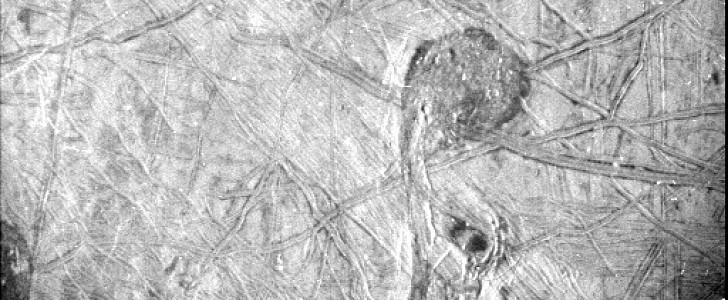On September 29th, NASA's Juno spacecraft had a close-up encounter with Jupiter's icy moon Europa. The probe flew at a distance of about 256 miles (412 kilometers) from the frozen crust, taking some incredibly sharp images of the frozen world. One image beamed back by June reveals a detailed view of some of Europa's most fascinating geologic formations.
Jupiter's moon Europa has long fascinated scientists because it is thought to harbor a vast salty ocean beneath its icy shell. Researchers believe the ingredients of life may be present in both the satellite's thick crust and this subsurface ocean, so they are seeking to uncover the mysteries of the frozen alien world.
The Juno spacecraft, which has been circling Jupiter since 2016, made its closest approach to Europa on September 29th, capturing some incredibly sharp images of its cracked surface. The probe used its Stellar Reference Unit (SRU) star camera to take a black and white picture of a region characterized by a network of fine grooves and double ridges that indicate raised features in the ice.
This is the first close-up image taken by a spacecraft in almost two decades. The picture shows the moon's geologic features in great detail. There are some dark stains that could signify something from below had once erupted onto the surface.
Perhaps the most intriguing feature is the one close to the center of the image, which looks like a musical quarter note. You can also notice some white spots in the photograph. These are indications of high-energy particles from the intense radiation that bombards Europa.
Heidi Becker, the lead co-investigator for the SRU, said that "this image is unlocking an incredible level of detail in a region not previously imaged at such resolution and under such revealing illumination conditions." This detailed view of the frozen shell of the moon helps scientists better understand how the features formed and "how they connect to Europa's history."
However, the data gathered by Juno offers just a glimpse of what NASA's Europa Clipper mission will uncover. The agency intends to send a spacecraft to Europa in 2024 to properly explore the moon in order to determine whether it could harbor conditions suitable for life.
The Juno spacecraft, which has been circling Jupiter since 2016, made its closest approach to Europa on September 29th, capturing some incredibly sharp images of its cracked surface. The probe used its Stellar Reference Unit (SRU) star camera to take a black and white picture of a region characterized by a network of fine grooves and double ridges that indicate raised features in the ice.
This is the first close-up image taken by a spacecraft in almost two decades. The picture shows the moon's geologic features in great detail. There are some dark stains that could signify something from below had once erupted onto the surface.
Perhaps the most intriguing feature is the one close to the center of the image, which looks like a musical quarter note. You can also notice some white spots in the photograph. These are indications of high-energy particles from the intense radiation that bombards Europa.
Heidi Becker, the lead co-investigator for the SRU, said that "this image is unlocking an incredible level of detail in a region not previously imaged at such resolution and under such revealing illumination conditions." This detailed view of the frozen shell of the moon helps scientists better understand how the features formed and "how they connect to Europa's history."
However, the data gathered by Juno offers just a glimpse of what NASA's Europa Clipper mission will uncover. The agency intends to send a spacecraft to Europa in 2024 to properly explore the moon in order to determine whether it could harbor conditions suitable for life.





